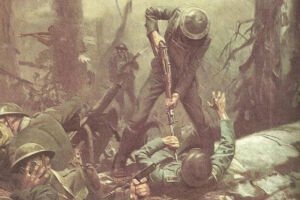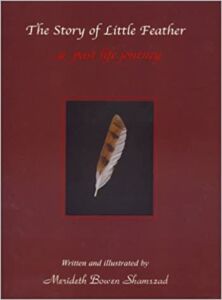 Abstract
Abstract
A hypothesis—there are often past life roots to present life psychological patterns.
Belief systems influence the filter through which behavior is interpreted. Regression therapy challenges several longstanding paradigms in traditional psychology. Based on a one lifetime only viewpoint, the assumption is made that the roots of behavior either stem from childhood or are a result of biochemical imbalances. The more traditional model also tends to see the unconscious as layered more linearly, with the earliest memories being the deepest and therefore hardest to access. These four past life cases present contrasting interpretations based on such belief systems models.
The ongoing debate on this subject tends to categorize opinion into two opposing camps. Most popular with traditional schools of psychology is the view that so called past life memories are just some manifestation of subconscious processes where Freudian symbolism meets with Jungian archetypes. The often cliché excesses of “reincarnationalism” insists on the literal view of past life recall. I propose that neither is true, and in a paradoxical way both are true simultaneously. It is not a matter of either one or the other theory being correct. For outside either of these two camps is the growing number of psychologists amassing considerable evidence that, in the way the deep subconscious is organized, both the archetypal level and the literal experience can and do co-exist.
Jungian analyst Roger Woolger (1988) developed a model that places the karmic or past life complex midway between an archetype, which has no personal memory trace and a complex which derives from personal experience in this life. Woolger’s term, karmic complex (1988, p. 150), is simply a modern Western term for the ancient concept of samskara in Eastern psychology. This refers to that which has been wrought, cultivated, brought to form or, in the case of an individual personality with its characteristic adornments, scars and quirks, that which has been in the process of concoction for lifetimes. According to Woolger (1988) this karmic complex “offers the missing keystone in the overarching bridge between Eastern and Western psychologies” (p. 150)
A psychological pattern, or complex, can be viewed as a type of web or knot, with the various strands/threads being composed of biographical material, archetypal contents, somatic expressions, past life levels, along with the current life condition. Following any thread can lead into the complex. For example, it does not matter whether one starts with the biographical, archetypal or past life level. Any one strand can reverberate across the web and bring to conscious awareness other components in the complex. Therefore, the debate to determine whether such contents are either archetypal or literal past life memories misses the point. They are often both archetypal and literal memories at the same time. Or to follow the above image; two of the strands/threads create the web/knot in the same complex.
The above model also fits the emerging worldview that corresponds with quantum physics—that the psyche is arranged in a non-linear, more holographic way. The linear cause and effect models in western psychotherapy, which echoed Newtonian physics, assumed causality for personality starting in childhood which was structured in a linear arrangement in the subconscious (i.e. the further back in linear time, the more difficult for the conscious mind to access). The Western bias toward materialism also accepted only physical, genetic inheritance of temperament. What research in past life therapy is revealing is that there may also be a type of non-physical soul, or psychic inheritance from our own past life history, which swirls together with archetypal material and a person’s current biography to blend into the unique personality of a given individual.
Case #1 – John
 Presenting problem:
Presenting problem:
Man in his sixties has difficulty with intimacy/ relationships with women. Out of touch with his emotions.
Traditional psychological viewpoint:
He was abandoned by his mother, never knew his father and spent many years as a child in an orphanage. John was finally adopted around the age of ten. This in turn has led to an inability to trust women or to be intimate with them. He tends to attract women who abandon him or women he abandons himself.
Past Life Perspective:
The significant contribution this case makes is that it challenges therapist and patient alike to view life circumstances, such as this tragic childhood, from another vantagepoint, rather than random powerless victim. For much of the theory/evidence in past life therapy points out that on some soul level, which differs from the ego personality, we choose our major life circumstances.
More background of the life story:
John is also very committed to a spiritual path in life. Such study and week-end retreats also take up much of his time and energy that would otherwise go into personal relationships.
In all of the five regressions John clearly saw the connection of his current life circumstances with these multiple past life scenarios. They are mostly Christian. In this current life John considered going into the priesthood, thereby continuing with that pattern. What stopped him from doing so was the Catholic Church rejecting him due to his orphan background, thereby being “abandoned” once again by the “Mother Church”.
As said before, this case challenges both patient and therapist to view life circumstances, such as this tragic childhood, from another vantage point. In the regression in which John saw this he was once again living in a spiritual community of monks in an Eastern culture. He was taken to this community as a child. In the culture in that lifetime, the youngest son was to be given to God. At some point he expressed a strong belief that led to a deep personal insight into his current life circumstances, in addition to a pattern seen in all other lifetimes. For in no life did John ever find himself in a loving family. As that “other life monastic figure” said, “Families steer a person away from the spiritual path and impede progress in that area.”
This is a significant, previously unconscious belief that has influenced his choices in many lives, contributing to a pattern. In Eastern terms this pattern is called a Samskara. An appropriate image to illustrate this concept is a groove on a vinyl record. When the needle hits a groove, the record is stuck on, it repeats over and over the sound at that point on the record. John was also stuck in this pattern, based on the belief that family life impedes soul growth. Therefore he “chooses” over and over to be in situations where there is no close relationships with parents and family. The soul is unconsciously “stuck’ in this pattern.
Important to address: It will take time to determine what impact this has on John’s life. The immediate shift is that he is taking fuller responsibility for his soul choices that led to such “abandonment” as a child. He can see/ grasp on a deep level his own soul participation in the circumstances of his childhood. This can lead to a person letting go of anger and resentment concerning the less than optimal, from an ego personality level view, conditions in life.
Case #2 – Scott
 Presenting problem:
Presenting problem:
Scott was a man in his mid-thirties, working successfully for a major corporation, who came to me to get help with mild depression, which he had felt all his life, even in what he described as a happy childhood. He had been to traditional psychologists and psychiatrists who had been unable to help him. The heaviness he felt most of the time was not alleviated. He described this heaviness as a dark cloud hovering around him.
Traditional psychological viewpoint:
There had to be some event in his childhood or some biochemical imbalance that contributed to these ongoing feelings of depression.
Past Life Perspective:
Although Scott informed me he had had loving parents and a happy childhood, that theory seemed inaccurate. No traumatic childhood event had ever been uncovered in his prior work with traditional mental health models. Nor did there seem to be a chemical imbalance since none of the medication the psychiatric model prescribed alleviated his symptoms.
The past life therapy model is willing to look “back” further than childhood to some traumatic unhealed event in another life that may be contributing to a person like Scott’s depression. Scott had mentioned his fascination, already as a child, with the First World War, particularly with the battle of Bellewood in France, which he had read about at some point. I thought this might hold a clue.
In his regression Scott went “back” to this battle of Bellewood. And he went back fully. This regression, some twenty years later, remains one of the most memorable of my career, for “he” was there completely—giving me a very emotional blow by blow account of what “he” was experiencing on the battlefield. Either “he”, in a past life, really had been there or Scott was a phenomenal actor!
As the story goes, he was a commander of a small group of men. He was injured and taken off the battlefield. Many of the men under his command were killed. This past life WWI soldier he’d been was left with a strong case of survivor guilt, which he never resolved, even though it appeared as if he lived into the 1940’s. This guilt was passed on in Scott’s emotional body for he had died with it unhealed. It was only in 1985 that this man he had been in 1917 was finally, 65 plus years later, able to express the emotions he’d held in check for the remainder of that life—and they were expressed through a future life, Scott.
Important to address: Critics of reincarnation would say Scott had read about this battle and his imagination took over. But here is another vantage point to look at the same thing. Could his soul have led him to read about it in order to awaken this unhealed event in him in order to heal it? What is so convincing and significant is that, after this one regression, Scott experienced an alleviation of his symptoms immediately in his life. Friends even told him he seemed lighter to them.
Case #3 – Lauri
 Presenting problem:
Presenting problem:
Lauri was a woman in her early thirties who was gifted with psychic ability. However, she had many fears regarding this talent:
- Guilt about her aptitude in this area.
- Fear her husband would leave her if she expressed/used it.
- Fear of being wrong and hurting someone due to this knowledge.
- Irrational fear of losing her children when and if she ever had them/ at this point she was childless.
Traditional psychological viewpoint:
Lauri is suffering from a generalized anxiety disorder. Weekly talk therapy, lasting for at least several months, plus anti-depressant medication may be prescribed. If the anxious thoughts become extreme enough, a tranquilizer could be considered.
Past Life Perspective:
The regression: Lauri went to a time in Colonial New England, near Boston, around 1657. She was a spiritual healer and psychic who was able to foretell the future. She played a leadership/teacher role to a group of women with similar talents. However, such skills were frowned upon and considered evil by the puritanical church authority. Her husband was also threatened by Lauri’s (who Lauri was in the past life) abilities and abandoned her and her two children. Later “Lauri’s” children disappeared one day. She feared someone had taken them. As she looked for her children a man captured her and dragged “Lauri” to a cold, dank basement. It was autumn. There were two other women from “Lauri’s” group there also. “Lauri” felt responsible for getting them into this predicament, as they were followers and students of hers. They knew they would be killed. “Lauri” was the last one they murdered. The other two were executed first as an example so “Lauri” would see it and know what she’d done to them. The technique used in that time and culture was to crush the victim by use of heavy rocks placed on the prone body until death came from asphyxiation and broken bones.
She died without ever seeing her children or knowing what happened to them. At the time of death her greatest concern was for her children’s well-being and for the guilt she felt at having contributed to the death of the other women.
This past life traumatic death holds the key to all of Lauri’s current fears listed above. As a result of making this past life conscious in this session, plus three other sessions in which Lauri accessed other relevant lives, a healing process began. The results in her life are very tangible and visible. Lauri has claimed her abilities and uses them professionally. Five years later Lauri is a successful medium, similar to the well-known American medium John Edwards, who assists many people with her talent and heart felt healing ability. She now has a young child and a loving husband, and her fears of losing them are gone.
Important to address: What is significant about this story is it illustrates that importance of consciousness at death and the impact that has on future lives. The last thoughts and feelings at death carry a deep unconscious imprint on the emotional body, which carried over to subsequent lives. This is why it is so important to prepare people consciously to make that transition and for them to be at peace as much as possible at the moment of death. Our culture would serve people far better if we would focus on this spiritual/psychological level of death. Instead in our current medical model approach to illness we place, what I believe to be, obsessive attention on technology and keeping the body alive artificially, while ignoring the soul’s needs.
Case #4 – Merideth
 Presenting problem:
Presenting problem:
Feelings of deep sadness that permeate her life in spite of a husband and children she loves and a positive, secure family life during childhood. Inexplicable sense of not belonging that had been with her all her life.
Traditional psychological viewpoint:
Depression may stem from a biochemical imbalance. Some unconscious and repressed trauma from childhood could also be at the root of such feelings.
Past Life Perspective:
Merideth presents another model on how to access and resolve and heal past life roots of current emotional patterns. Rooted in a safe home and community, Merideth is able to risk exploring these emotions mainly through painting scenes that come to her through inner visions. She has since published a book of these paintings along with a story of a lifetime as Little Feather, an American Indian male who, with his tribe, was wiped out during America’s heinous history of genocide of Native Americans. As she writes, “I entered Little Feather’s life through the doorway of grief, which has waited outside of time for me to come back to it.”
Merideth spent many years processing these emotions from this life, mostly through her paintings and occasionally adding expressive dance as a healing tool. As a result of these efforts she now feels a joy of living she hadn’t felt previously. She no longer experiences debilitating sadness and a lack of belonging to the current culture in which she finds herself in the early 21st century. She still maintains a love and appreciation of nature and a love of horses she’d developed in her lifetime as an American Indian.
Important to address: Hypnosis and altered state work with a therapist is not the only way to access and heal past life memories. Merideth presents the model of using art as a route to both self-knowledge and self-healing.
References
Woolger, R. (1988). Other lives, other selves: A Jungian psychotherapist discovers past lives. New York City: Bantam Books.
